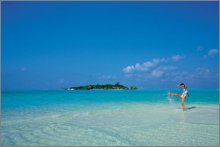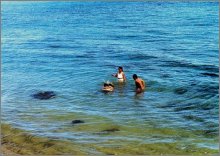Rip Currents & Other Hidden Hazards Everyone Who Swims and Plays in Oceans or Lakes Needs to Know
by www.SixWise.com
Most trips to the beach are pleasantly uneventful with visitors
taking in the sun, sand and surf, and maybe searching for
a seashell or two. Assuming you know how to swim, choose a
day when the weather is good and the water is calm, and don't
stay out in the sun for too long, the beach hardly looks like
a place full of potential hazards … but in this case
looks can be deceiving.
|

More than 50,000 people were rescued from the nation's
beaches in 2005.
|
Oceans and lakes are home to powerful currents, tides and
waves that can come up seemingly from nowhere and quickly
devastate the life of someone who happens to be in the wrong
place at the wrong time. What makes this issue so crucial
is that these potentially hazardous conditions can, and do,
exist in seemingly innocent water, and often not far from
shore.
Dangers at the Beach
Minor to severe injuries occur at beaches everyday. Some
of the most common include:
-
Sunburn
-
Heatstroke
-
Jellyfish stings
-
Cutting your foot on a piece of glass/metal
-
Abrasions from coral, rocks, etc.
-
Burns from fire pits
However, venturing into the water brings on a whole new set
of potential dangers. In 2005, more than 50,000 people were
rescued from the water by a lifeguard, according to the U.S.
Lifesaving Association. Another 71 people died at the beach
from drowning, and over 200,000 people were injured and required
medical attention.
B. Chris Brewster, president of the U. S. Lifesaving Association
and a lifeguard himself, believes the actual number of injuries
and deaths that occur at beaches each year is probably even
higher than that.
Avoiding Rip Currents: The Most Common Cause of Beach
Rescues
Of the rescues made at beaches, 80 percent are related to
rip currents. In 2005, 22,544 people in all were pulled from
a rip current's grasp, and the U.S. Lifesaving Association
estimates that over 100 people may die due to rip currents
each year.
Rip currents are channeled currents of water that flow powerfully
away from shore. They can be narrow or stretch over 50 yards
across, and they move very quickly. Average rip currents move
from one to two feet per second, but some have been clocked
at eight feet per second.
These dangerous currents can occur at any beach that has
breaking waves, which includes oceans and the Great Lakes.
Extending from the shoreline past the line of breaking waves,
rip currents can easily pull even the most seasoned swimmer
out to sea.
Whenever you are at the beach, keep your eye out for potential
rip current warning signs. Rip currents usually occur when
waves are high and contain choppy, churning water that will
stir up sediment and sand and may change the color of the
water. You may also notice a line of foam, seaweed or other
debris moving out to sea, or notice a change in the normal
incoming wave patterns.
Upon arriving at the beach, you should also look for any
posted warning signs and obey the cautions they contain. You
can also ask any lifeguards on duty whether rip tides are
a risk in the area.
What to do if You're Caught in a Rip Current
If you feel yourself being pulled away from shore, you may
be caught in a rip current (rip currents pull you out to sea,
not under). Most importantly, try not to panic. Swim parallel
to the shore until the current relaxes, and then swim at an
angle (away from the current) back to shore. Do not fight
the current and try to swim directly back to shore, as you
may not be able to overcome the fast water and may become
tired.
Usually, rip tides are narrow enough that a short parallel
swim will bring you to safety. In the event that you cannot
break free, however, tread water or float and call or wave
for help. If you feel the current weaken, swim parallel and
then at an angle back toward shore.
|

If you feel a rip current pulling you out to sea, swim
parallel to shore until the current weakens -- do not
try to fight it by swimming directly inland.
|
Hard-Breaking Waves
Bodysurfing and boogie-boarding is a favorite beach activity,
but waves are powerful and can break hard, easily plunging
swimmers downward and slamming them onto the sand. Neck and
spinal cord injuries can easily occur if the head or neck
strikes the bottom.
Waves of this type are often unexpected, as Josh Basile knows
all too well. In 2004, at the age of just 18, Basile was boogie-boarding
in waist-deep surf at a Delaware beach when a wave picked
him up and slammed him headfirst into the sand.
He sustained neck and spinal cord injuries that paralyzed
his arms and legs. In the two years that followed, he underwent
a barrage of intense therapies and is now able to partially
move his arms, fingers and toes.
Determined to let others know about this little-known danger,
he has been giving speeches to college and high school students
to educate them about beach safety.
"When sand is wet, it's as hard as concrete," Basile
said, "I know 10 people with spinal cord injuries just
in my area because of the beach."
Some scientists believe that hard-breaking waves are especially
problematic at stretches of shoreline that are being replenished
to replace sand that has disappeared due to erosion or storms.
In such areas, steep slopes underwater are made even steeper,
and points where deep water turns shallow cause waves to build
in high, then break suddenly, and hard.
The best way to avoid hard-breaking waves is to stay aware
when you're in the surf. Don't turn away from incoming waves,
and stay out of the water if waves get too high.
More Beach Safety Tips
The U.S. Lifesaving Association offers these additional tips
to make sure your trip to the beach is a safe one:
-
Only swim when a lifeguard is present. The chance a person
will drown while at a beach protected by a U.S. Lifesaving
Association lifeguard is one in 18 million.
-
Learn how to swim.
-
Never swim alone. Always have one or more friends with
you, or at least watching from the beach.
-
Don't dive headfirst until you are SURE the water is
deep enough and clear of obstructions. Go in feet-first
your first time.
-
Avoid combining swimming with alcohol, which can impair
your judgment and swimming ability.
Recommended Reading
Before
You Swim This Summer, You Should Know What Is Lurking at Your
Beach
Finding
Cures Under the Sea: The Search for New Medicines in Our Oceans
Sources
Washington
Post: A Spirit the Waves Couldn't Break
USA
Today June 5, 2006
U.S.
Lifesaving Association
National
Weather Service Rip Current Awareness
National
Drowning Prevention Alliance